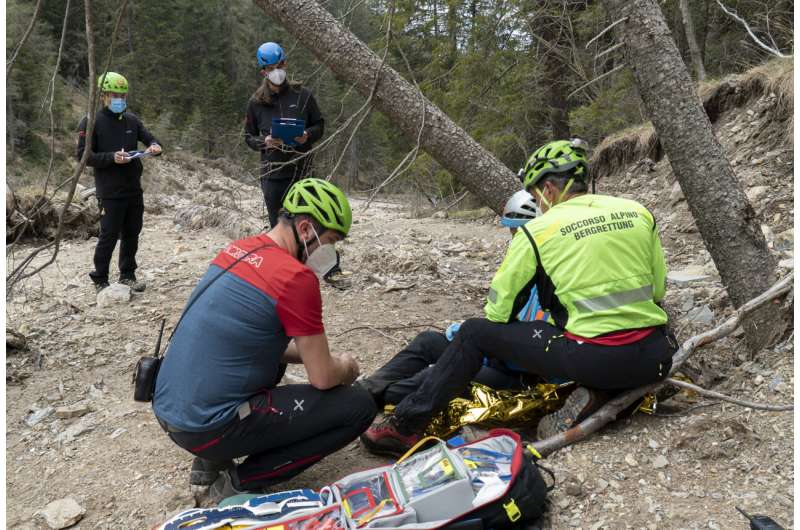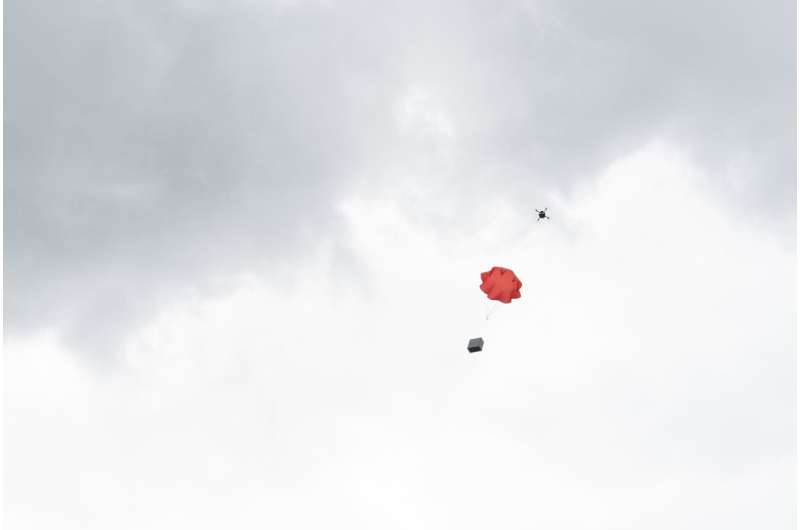This article has been reviewed according to Science X's editorial process and policies. Editors have highlighted the following attributes while ensuring the content's credibility:
fact-checked
peer-reviewed publication
proofread
First aid: Drones make a difference

Eurac Research and Mountain Rescue South Tyrol tested the use of drones to locate and rescue accident victims in Bletterbach Gorge. The results are in, drones save valuable time and increase safety for rescue services in inaccessible areas.
The Eurac Research-led team simulated 24 missions at different locations in the Bletterbach Gorge. Locations were chosen where, according to reports from the South Tyrolean Mountain Rescue, accidents have actually occurred in the past decade.
From traumatic injuries such as fractures and dislocations to bruises, the conditions in the gorge are ideal for testing the use of drones in locating and providing first aid to injured people in difficult-to-access terrain. Emergency physician at Eurac Research Michiel van Veelen explains: "It is particularly difficult to locate injured people here. Cell phones don't have reception and the area is difficult to access."
The tests
The tests compared response times with and without the drones and at the same time, recorded the rescue teams' vital functions such as heart and respiratory rates, skin temperature and ECG curves.
"The data provides information about the stress everyone is exposed to," explains Giacomo Strapazzon, director of Eurac Research's Institute for Mountain Emergency Medicine. 'We want to know if drone-assisted rescue operations actually give the people involved a greater sense of efficiency and safety." For this evaluation, rescuers had to fill out a questionnaire before and after the operation.
In addition to the camera, the drones can also carry small packages containing radios, thermal blankets, personal protective equipment and first aid supplies which are delivered near the accident scene.
Giacomo Strapazzon points out the main advantages of using a drone: a fast location of the accident site and the use of telemedicine. In fact, once the package has arrived in the vicinity of the injured person, first responders can already begin rescue thanks to the instructions they receive via radio from 112 personnel.

The results of the study are now available as a publication in the American Journal of Emergency Medicine. After evaluation, the following data was discerned ̶ in drone-supported missions there was a reduction of 30% in the time needed to locate the casualty. The average time needed to begin treatment was also reduced by an average of 30 % thanks to the drones. This was especially true for cases of traumatic injuries and cardiac arrest, where time gained can be critical to survival.
In bad weather
However, drones are not always infallible, and this was shown by the 4 missions that failed due to technical problems. Because of this, electronic engineers have also been involved in the project with the aim of further developing drone sensor technology to locate victims more quickly in bad or adverse weather conditions.
In a recently approved follow-up project, emergency physicians and electrical engineers from Eurac Research are collaborating with the NOI Techpark-based start-up MAVTech to develop a first aid drone for cases of cardiac arrest in mountainous areas. For this purpose, these drones are equipped with a defibrillator that can be easily handled by anyone.
In Stockholm, such drones have already been successfully tested in the city, says Michiel van Veelen.
"In the case of cardiac arrest, going from life to death is just a matter of minutes, and in South Tyrol there are an average of 50 cardiac arrests a year in hard-to-reach areas," van Veelen further explains.
All the data (including timing) for several previous cardiac arrest rescue missions which actually occurred in mountainous areas is available and with this information, re-enactments with a drone are taking place for the follow-up project. In order to equip these airborne rescue technologies for all weather conditions, the MAVTech company drones were exposed to extreme conditions in the terraXcube and adapted accordingly, making it possible for them to be used even in adverse weather conditions in the future.
More information: Michiel Jan van Veelen et al, Drones reduce the treatment-free interval in search and rescue operations with telemedical support—A randomized controlled trial, The American Journal of Emergency Medicine (2023). DOI: 10.1016/j.ajem.2023.01.020




















